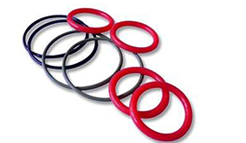 The o-ring is one of the simplest and most versatile sealing devices on the market. These compact and unassuming items are used across every industry and market and arguably the best seal for many applications. Their popularity is due to their ability to perform in dynamic and static applications, work in temperatures ranging from -65°C to +325°C depending on material type, effectively seal in both directions, and most importantly, occupy very little space. When choosing an o-ring there are several factors that should be considered for a long-life performance including identifying the application, determining the media that needs to be sealed, the required size, as well as the environment and elements the o-ring will be exposed to. Here are a few simple steps to help you choose the correct o-ring for the application at hand.
The o-ring is one of the simplest and most versatile sealing devices on the market. These compact and unassuming items are used across every industry and market and arguably the best seal for many applications. Their popularity is due to their ability to perform in dynamic and static applications, work in temperatures ranging from -65°C to +325°C depending on material type, effectively seal in both directions, and most importantly, occupy very little space. When choosing an o-ring there are several factors that should be considered for a long-life performance including identifying the application, determining the media that needs to be sealed, the required size, as well as the environment and elements the o-ring will be exposed to. Here are a few simple steps to help you choose the correct o-ring for the application at hand.
Determine the Application For the Seal
Based on the nature of your application, you can easily select the correct type of o-ring that will sustain pressure, temperature and other factors sufficiently.
Choose Your O-Ring Based on Materials Makeup
One of the reasons that o-rings function effectively in so many applications is because there is a diverse scope of material used in their fabrication. Many o-rings are made from durable rubber or elastic polymers, but depending on what you require Silicone o-rings, Fluorosilicone o-rings, and many more are available. It can be difficult to determine which is appropriate for a project because of the wide variety of materials available. To make it a little easier, download Manufacturer’s Rubber and Supply’s Reference Guide for O-ring Materials for a comprehensive overview of the materials, what they are used with, which materials not to use them with, as well as some other helpful information.
Ensure that the Material You Choose Will Withstand the Temperature of Your System
The durability of the O-ring depends upon sustainability in the extreme conditions it is operating in. To choose the most viable o-ring for your specific application, factors like temperature and pressure levels will need to be considered. Depending on the material type, o-rings can perform in temperatures ranging from -65°C to +325°C.
Choose the Correct Tightness for Your Hardware
Based on the seal’s tightness, you can choose the suitable type of O-ring for your application. Specify the hardware design that will be used in the application first because this design will make an impact on the O-ring squeeze ratio as well as the compressive force of the ring. Determining the O-ring squeeze ratio will tell you about the force that is applied to the hardware that results from tightening of the seal. When you choose the right type of O-ring, it will be able to tolerate the compression and pressure accordingly.
Choose a Standard Size O-Ring or Contact Us for a Custom Mold
Once you have determined the application, material, and correct fitting, it should be easier to narrow done the correct o-ring. At Manufacturer’s Rubber & Supply, we offer one of the largest inventories of o-rings available and that suit a wide variety of needs. View our selection of standard o-rings by downloading the O-Ring Sizing Chart.
In addition to our standard o-ring products, we also offer custom options, maintenance kits, accessories, and even spliced and vulcanized materials. If you would like to learn more about choosing or ordering o-rings, request a quote, or give us a call at 800-727-7763 for more details.

